Winter is approaching, heavy snow in on the way, and my wife and I were vehicle shopping. Our Ford Escape clicked over 125,000 miles and there is a need for something reliable that will traverse snow and ice covered, pot hole riddled, Maine roads. A truck came to mind. Nothing special, just something with a bit of power and a 4×4 drive train.
Visiting each of the automotive manufacturer’s web sites, we read and digested information and spun 3D models around to get a sense of vehicle appearances until we were dizzy. Models of interest were then “built” to completion, to reflect everything our hearts desired, while watching the prices roll up like a $4 a gallon gas pump. Each exercise began with a base price of $20,000, then quickly escalated in price to $102,004.36… give or take. How could that happen? Easy. A transcription of these interaction…
The Internet, “Would you like front fenders on your vehicle?”. Us, “Yes, please. Two if at all possible”. Internet, “The front fender package requires removal of the rear fenders and the addition of a chrome undercarriage, leather sun visors, a serious Sirius radio, front, rear, side, and terrain avoidance cameras, and a flue shot. This will add $32,019 to the price of your vehicle. Continue?”. Us, “What about the rear fenders?” Internet, “That would require exterior trim package 203B which includes: rear fenders, 25″ wheels, off the road tires, on the road tires, a heated tail gate, clear weather fog lights, interior lava lamp lighting, and deletion of front fenders. This will subtract $32,019 and add $82,004.36. Continue?”.
Eventually, we decided my wife would give me a TIG welder for Christmas and then I would fabricate a new truck from our garden tractor spare parts supply and any pieces that have fortuitously fallen off our Escape. A plan that still requires sorting but, for now, we will sleep at night in the absence of a purged savings account and/or 72 months of truck payments that amount to aggravated assault. Moving right along…
Compact rifles for everyone
 I owned a Remington Model Seven for a very long time. It was fast, well balanced and well made. I loved the fact it came with metallic sights that were more then enough for hunting in thickly wooded New England. If I felt like some range time, or a need to work on accuracy of handloads, I’d just mount a scope to the drilled and tapped receiver. I liked the feel of the laminated stock; hand filling, substantial and with a pattern that blended in with fall and winter colors. I sold it but because the caliber, 223 Remington, was a little light for deer.
I owned a Remington Model Seven for a very long time. It was fast, well balanced and well made. I loved the fact it came with metallic sights that were more then enough for hunting in thickly wooded New England. If I felt like some range time, or a need to work on accuracy of handloads, I’d just mount a scope to the drilled and tapped receiver. I liked the feel of the laminated stock; hand filling, substantial and with a pattern that blended in with fall and winter colors. I sold it but because the caliber, 223 Remington, was a little light for deer.
I owned a Remington Model Seven CDL chambered for the 260 Remington. Very accurate, very good on deer size game, easy on recoil… a very pretty rife. I sold it because of a narrow range of component bullets and loaded ammunition… and because I also owned a 6.5 Swede.
The pictured Remington Model Seven Laminate is chambered for the 243 Winchester, a cartridge used with great success on many deer and hog hunts. By comparison, the stock is darker than my old Model Seven, the fit and finish is nicer, the trigger is much better, and it is more accurate. This combination also offers many choices in handload components and loaded ammunition.
|
Remington Model Seven Laminate |
|
| Company | Remington |
| Point of Manufacturer | Ilion, NY |
| Item # | 85961 |
| Type of Action | Bolt, Short Action |
| Caliber | 243 Winchester |
| Magazine Capacity | 4 |
| Magazine Type | Internal – Hinged Floorplate |
| Barrel Length | 18.5″ |
| Barrel Material | Carbon Steel |
| Barrel Finish | Black Oxide |
| Rifling Twist Rate | 1:9 1/8″ |
| Receiver Material | Carbon Steel |
| Stock Type | Straight Comb – No Cheek Piece |
| Stock Material | Laminated epoxy/birch |
| Length of Pull | 13 3/8″ |
| Drop at comb | 1 1/4″ |
| Drop at heel | 1 1/2″ |
| Trigger Guard Material | Aluminum |
| Front Sight | Ramped, White Bead |
| Rear Sight | Adjustable W/E |
| Scope Accommodation | Drilled and tapped Receiver |
| Trigger Type | X- Mark Pro Adjustable |
| Weight of Firearm | 6 1/2 Lbs |
| Overall Length | 37 3/4″ |
| Safety | 2 Position Thumb |
| MSRP | $1,039 |
For folks who don’t agree with my choice of cartridges, the Model Seven Laminate is also available in 223 Remington, 7mm-08 Remington and 308 Winchester. For folks who don’t share my enthusiasm for metallic sights and laminated stock, the Model Seven is also available with Walnut and Synthetic stocks.
“OK, Joe, quit screwing around with non-essential verbiage and just tell me why I might find this firearm useful”. Sure. First of all, it is a good looking firearm. Please don’t tell me that does not matter, because part of the attraction of firearms are found in the packaging of a design. Some firearms feature craft skills; fine wood, clean metal work,and artful embellishments.The Model Seven does something unique in combining firearm technology and aesthetic appeal in a very clean firearm produced that is produced predominately by machines.
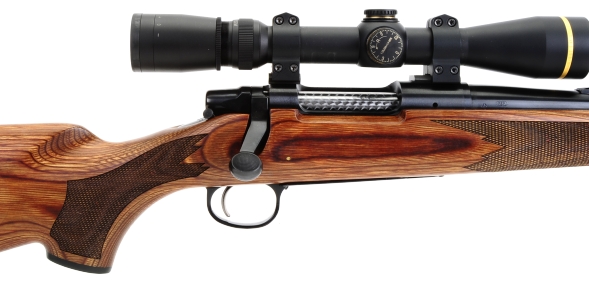
The checkering is machine cut, not hand cut, the patterns are clean, coverage is appropriate and the gripping surface does not feel slick even in wet or snowy weather. The checkered bolt knob, the jeweled bolt body and a deep blued finish overall are of excellent quality, not found on many factory firearms these days.
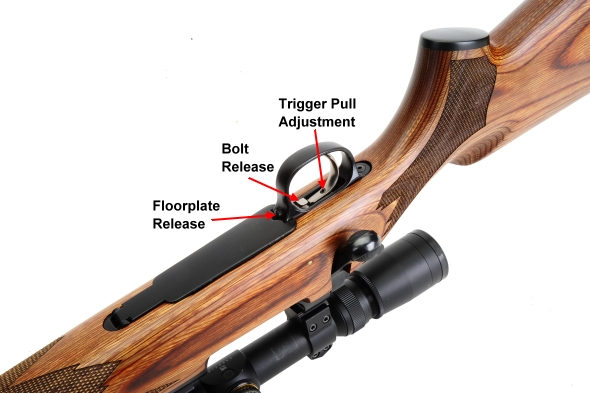
Not cheaply made, the Model Seven has a hinged floorplate and an internal magazine that holds four rounds. The floorplate is released by depressing the button at the outside top of the trigger guard, the bolt is released for removal by depressing the tab at the inside top of the trigger guard. The set screw in the trigger adjusts pull for the Mark X Pro trigger assembly.
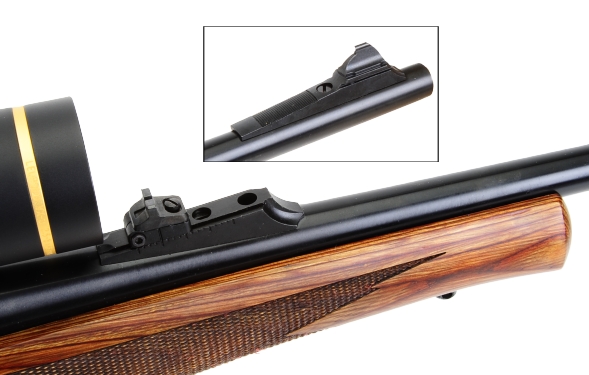
The Remington Model Seven’s sight set is not an after thought. The rear sight is steel. Elevation is controlled along a grooved ramped base, windage is adjusted and locked with a set screw. The front steel sight is ramped and has a white bead face. Together, front and rear present an excellent sight picture that is glare free and clean in profile.
The laminated stock is fitted with a clean poly grip cap and swivel studs. The Schnabel (German=beak) forend is a nice touch that adds aesthetic balance; the geometry of a rifle should not send your eyes off in antithetical directions.
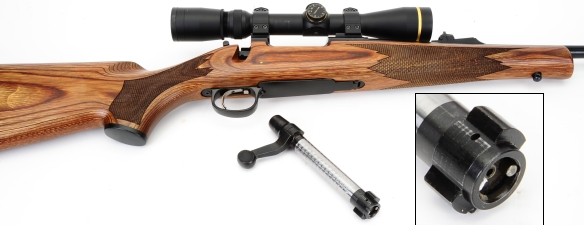 The bolt, appearing in this order only because it was out of the rifle, has: twin opposing lugs, 90º lift, a stamp steel extractor recessed in the bolt face, and a plunger type ejector… boing. You may have to chase brass, but that empty is going to come out and make room for the next round. The Remington Model Seven has, of course, the three rings of steel design that seals the chamber and protects the shooter; case head in the bolt face, bolt face recessed into the barrel and both wrapped in the steel walls of the receiver. As a handloader I have don’t some shameful things to the Model Seven.. no, not stupid things, and the rifle has held up well. The difference between shameful and stupid? Sure. Shameful is when you consistently load near the top of Pmax SAAMI pressure spec. Stupid is when you exceed that level, pull the trigger, utter “Good grief!”, and then yell over your shoulder for your buddy to gather the pieces of your rifle while they are loading you into an ambulance.
The bolt, appearing in this order only because it was out of the rifle, has: twin opposing lugs, 90º lift, a stamp steel extractor recessed in the bolt face, and a plunger type ejector… boing. You may have to chase brass, but that empty is going to come out and make room for the next round. The Remington Model Seven has, of course, the three rings of steel design that seals the chamber and protects the shooter; case head in the bolt face, bolt face recessed into the barrel and both wrapped in the steel walls of the receiver. As a handloader I have don’t some shameful things to the Model Seven.. no, not stupid things, and the rifle has held up well. The difference between shameful and stupid? Sure. Shameful is when you consistently load near the top of Pmax SAAMI pressure spec. Stupid is when you exceed that level, pull the trigger, utter “Good grief!”, and then yell over your shoulder for your buddy to gather the pieces of your rifle while they are loading you into an ambulance.
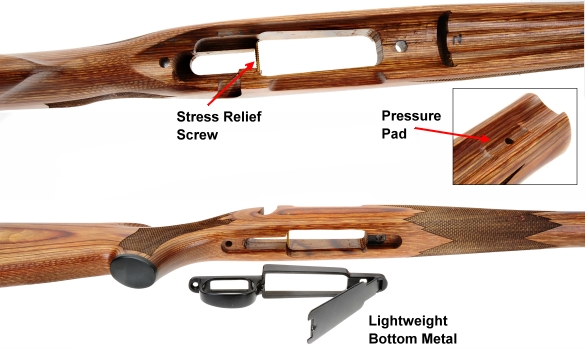
The Model Seven Laminated stock fit to action does not use the “pillar bed and let the rest float” approach. Rather, the round bottom receiver is pulled up against the hard laminate, it is anchored longitudinally by a beefy recoil lug that is sandwiched between barrel and action and then tucked into an accommodating recess inletted into the stock. A pressure pad located near the front of the forend stabilizes the barrel and assures a return to zero. A cross screw between the trigger and magazine well bring further stock stability.
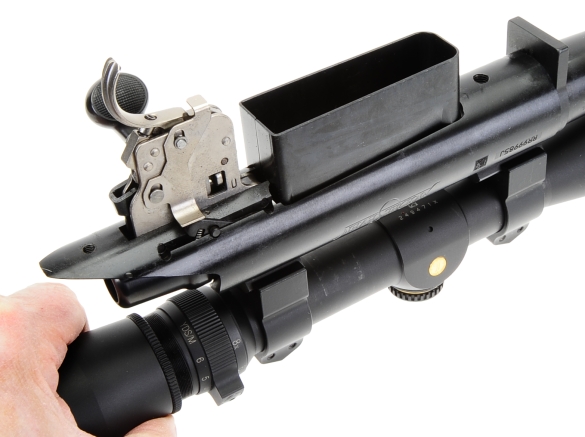
One of the reasons why I like Remington rifles, they are as cleanly machined and finished in the areas that don’t show, as much as the areas that do show. The recoil lug, as shown at the end of the receiver, is substantial. The X Mark Pro trigger is very clean; no creep and a crisp let off. The set screw in the face of the trigger adjust pull resistance. The subject rifle was set to 5 1/2 lbs as received. One counterclockwise turn of the adjusting screw brought pull to my hunting rifle preference, 4 1/4 lbs where it remained for the duration.
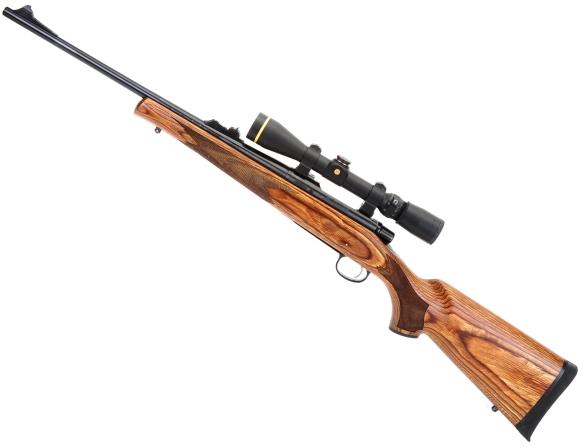
The Model Seven length of pull is shorter than a Model 700, but not by much at 13 3/8″. Devoid of cheek piece, the Seven has minimal drop and works well to provide line of sight with even jug head support, with and without a scope mounted.
And what about that 243 Winchester round?
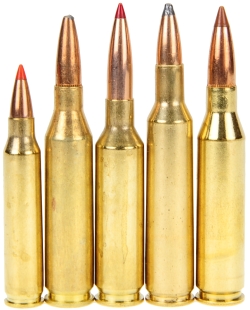 I think we are all biased by field experience, hopefully, not overly so by gun forums and testimony from HokiePokie416. Unfortunately, even field experience requires some interpretation. The fact that a 30-06 Springfield barrage did not drop a whitetail does not mean the cartridge is at fault and should be stricken from a compilation of cartridges suited for deer. By the same token, a skilled marksman’s success with the 22 Mag does not mean it should head that list. For me, the 243 Winchester round has performed competently as a deer hunting round, based on one shot, drop in its tracks performance with heart/lung shots on deer. Yes, it could have been a case of cooperative deer, although they did not seems so when tracking them up and down steep hill sides all day.
I think we are all biased by field experience, hopefully, not overly so by gun forums and testimony from HokiePokie416. Unfortunately, even field experience requires some interpretation. The fact that a 30-06 Springfield barrage did not drop a whitetail does not mean the cartridge is at fault and should be stricken from a compilation of cartridges suited for deer. By the same token, a skilled marksman’s success with the 22 Mag does not mean it should head that list. For me, the 243 Winchester round has performed competently as a deer hunting round, based on one shot, drop in its tracks performance with heart/lung shots on deer. Yes, it could have been a case of cooperative deer, although they did not seems so when tracking them up and down steep hill sides all day.
Pictured L-R: 223 Remington, 243 Winchester, 6mm Creedmoor, 6mm Remington, 260 Remington. The 223 Rem is a little light for deer. The 6mm Creedmoor is a ballistic twin to the 243 Winchester, but it accommodates longer and heavier match bullets in short action rifles. The 6mm Remington, AKA 244 Remington, is a great round for handloaders and can add power over the 243 Win, but there is little offered in factory ammunition. The 260 Rem is a good round, however, there are approximately three times as many loads for the 243 Win and components for handloaders are more plentiful and at a lower cost.
| Range 0 – 500 yards 105 grain@3000 FPS 271 Yards Point Blank Range with +3″ Max Ordinate |
||||||||||||
| Range | 0 | 50 | 100 | 150 | 200 | 250 | 300 | 350 | 400 | 450 | 500 | |
| Velocity – fps | 3000 | 2906 | 2813 | 2723 | 2634 | 2546 | 2461 | 2377 | 2295 | 2215 | 2137 | |
| Energy – ft.-lbs. | 2098 | 1968 | 1845 | 1728 | 1617 | 1512 | 1412 | 1318 | 1228 | 1144 | 1064 | |
| Momentum – lbs-sec | 45 | 44 | 42 | 41 | 40 | 38 | 37 | 36 | 34 | 33 | 32 | |
| Path – in. | -1.50 | 0.49 | 1.45 | 1.31 | -0.00 | -2.56 | -6.47 | -11.81 | -18.68 | -27.21 | -37.51 | |
Arguably, power and penetration should be good out to 500 yards, although trajectory and wind drift can get a little iffy where a target is not fixed in position. My use has always been inside 250 yards even where longer shots can be taken, which is my self imposed limit and. Currently, my perspective is from hunting in Maine where shots are often taken inside 50 yards. For anyone surprised by the 243 Winchester’s ballistics, the round was introduced as kind of a hot rod, made by necking down the 308 Winchester to 0.243″. That is a lot of powder behind a relatively small and light weight bullet.
I’m going to take a break and assemble some ammunition to go along with factory ammunition, then run some live fire results on the Remington Model Seven.

Email Notification